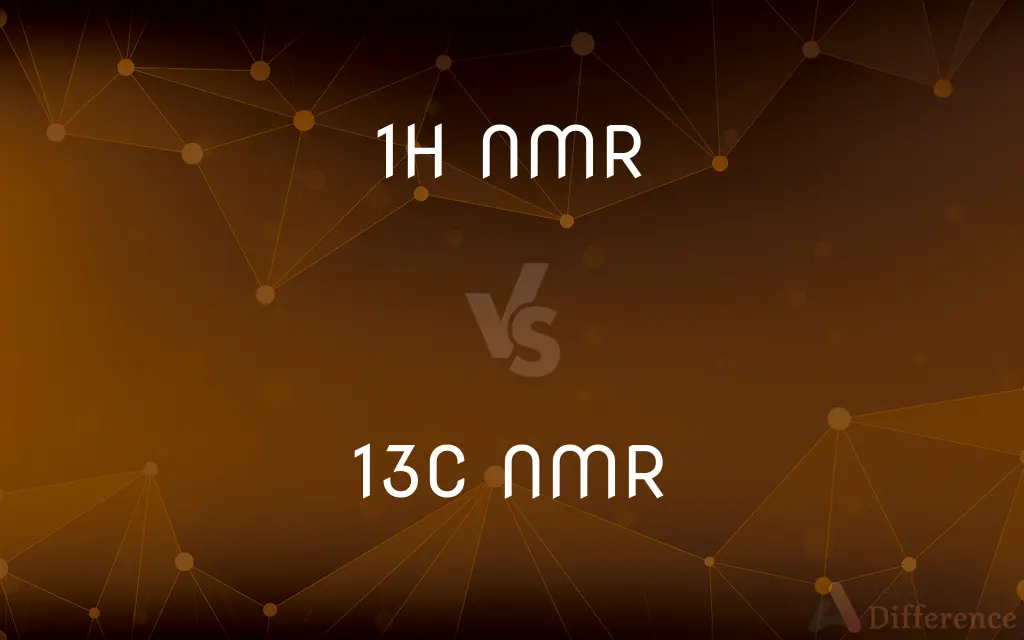1H NMR vs. 13C NMR — What's the Difference?
By Tayyaba Rehman — Published on January 5, 2024
1H NMR analyzes hydrogen atoms in molecules; 13C NMR focuses on carbon atoms. They provide different structural information in nuclear magnetic resonance spectroscopy.

Difference Between 1H NMR and 13C NMR
Table of Contents
ADVERTISEMENT
Key Differences
1H NMR spectroscopy, or proton NMR, is a technique that focuses on the magnetic properties of hydrogen atoms in a molecule. It provides detailed information about the hydrogen atoms' environment, helping to elucidate molecular structure.
13C NMR spectroscopy, on the other hand, targets the carbon-13 isotope. This technique is crucial for understanding the carbon skeleton of a molecule, offering insights into the arrangement of carbon atoms.
The sensitivity of 1H NMR is higher due to the abundance of hydrogen atoms in organic molecules and their high gyromagnetic ratio. This makes 1H NMR a more commonly used tool in molecular structure analysis.
Conversely, 13C NMR is less sensitive as the carbon-13 isotope is naturally less abundant. However, it provides complementary information that is crucial for a complete understanding of molecular structure.
In summary, both 1H NMR and 13C NMR are indispensable techniques in nuclear magnetic resonance spectroscopy, each providing unique and vital information about molecular structure.
ADVERTISEMENT
Comparison Chart
Focus
Analyzes hydrogen atoms.
Focuses on carbon-13 isotopes.
Sensitivity
Higher sensitivity due to abundant hydrogen atoms.
Lower sensitivity due to less abundant carbon-13.
Information Provided
Provides details on hydrogen environment.
Offers insights into carbon skeleton.
Common Usage
More commonly used in molecular structure analysis.
Used for complementary information.
Gyromagnetic Ratio
High gyromagnetic ratio.
Lower gyromagnetic ratio.
Compare with Definitions
1H NMR
Provides detailed hydrogen atom environment information.
The 1H NMR data helped us understand the hydrogen bonding.
13C NMR
Focuses on carbon-13 isotopes in molecules.
The 13C NMR spectrum helped identify the carbon framework.
1H NMR
Used to determine molecular structure and dynamics.
Through 1H NMR, we deciphered the compound's structure.
13C NMR
Important in organic and medicinal chemistry.
13C NMR was instrumental in our drug discovery research.
1H NMR
A spectroscopic technique analyzing hydrogen atoms.
The 1H NMR spectrum revealed the molecule's functional groups.
13C NMR
Used for detailed carbon skeleton analysis.
With 13C NMR, we mapped the molecule's carbon structure.
1H NMR
Has high sensitivity due to abundant hydrogen.
1H NMR is often the first choice in organic analysis.
13C NMR
Less sensitive due to carbon-13's lower abundance.
Despite its lower sensitivity, 13C NMR provided crucial insights.
1H NMR
Commonly used in chemistry and biochemistry.
We used 1H NMR to study the protein's conformation.
13C NMR
Complements 1H NMR for complete molecular analysis.
Combining 1H and 13C NMR gave us a full structural picture.
Common Curiosities
Is 1H NMR sensitive?
Yes, 1H NMR is highly sensitive due to abundant hydrogen atoms.
What information does 1H NMR provide?
1H NMR provides information about the environment of hydrogen atoms.
What types of atoms does 1H NMR analyze?
1H NMR analyzes hydrogen atoms in molecules.
What does 13C NMR stand for?
13C NMR stands for carbon-13 nuclear magnetic resonance.
What does 1H NMR stand for?
1H NMR stands for proton nuclear magnetic resonance.
What types of atoms does 13C NMR analyze?
13C NMR focuses on carbon-13 isotopes in molecules.
In which fields is 1H NMR commonly used?
1H NMR is commonly used in chemistry, biochemistry, and medicine.
In which fields is 13C NMR commonly used?
13C NMR is used in organic chemistry, medicinal chemistry, and material science.
What kind of samples can be analyzed by 1H NMR?
1H NMR can analyze a wide range of organic and biological samples.
Is special preparation needed for 1H NMR samples?
Samples often need to be dissolved in deuterated solvents for 1H NMR.
Is special preparation needed for 13C NMR samples?
Similar to 1H NMR, samples for 13C NMR usually require dissolution in deuterated solvents.
Is 13C NMR as sensitive as 1H NMR?
No, 13C NMR is less sensitive due to the lower abundance of carbon-13.
What information does 13C NMR provide?
13C NMR provides insights into the carbon skeleton of molecules.
What kind of samples can be analyzed by 13C NMR?
13C NMR can analyze organic compounds, polymers, and complex biological molecules.
Can 1H NMR and 13C NMR be used together?
Yes, they are often used together for a complete molecular analysis.
Share Your Discovery

Previous Comparison
Dengue Mosquito vs. Normal Mosquito
Next Comparison
DDR2 vs. DDR3Author Spotlight
Written by
Tayyaba RehmanTayyaba Rehman is a distinguished writer, currently serving as a primary contributor to askdifference.com. As a researcher in semantics and etymology, Tayyaba's passion for the complexity of languages and their distinctions has found a perfect home on the platform. Tayyaba delves into the intricacies of language, distinguishing between commonly confused words and phrases, thereby providing clarity for readers worldwide.













































